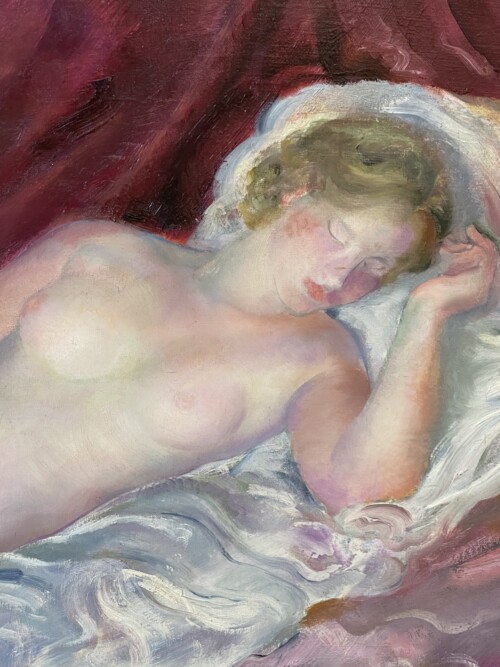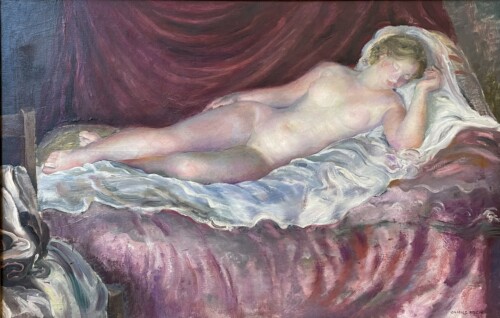-
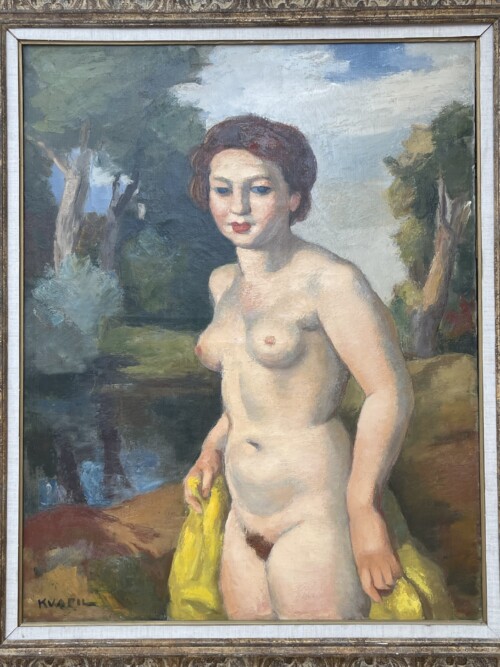
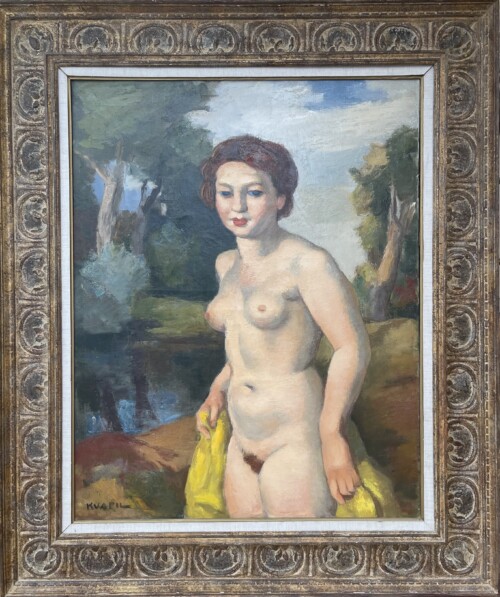 Charles Kvapil (1884-1957) était un peintre belge d’origine autrichienne, reconnu pour ses œuvres post-impressionnistes aux accents fauves. Né à Anvers, il étudie à l’Académie royale des beaux-arts d’Anvers puis à l’Académie Julian à Paris. Influencé par les maîtres impressionnistes et les courants modernes du début du XXe siècle, Kvapil développe un style personnel marqué par des couleurs vibrantes et une touche expressive. Il se spécialise dans les scènes de nus féminins, les portraits et les paysages, souvent baignés d'une lumière chaude et méditerranéenne. « Femme nue tenant un drapé jaune dans un paysage » Huile sur toile. Signée en bas à gauche. Circa 1930. Dimensions H : 91 cm ; L : 72 cm (sans cadre) H : 121,5 cm ; L : 102 cm (avec cadre)
Charles Kvapil (1884-1957) était un peintre belge d’origine autrichienne, reconnu pour ses œuvres post-impressionnistes aux accents fauves. Né à Anvers, il étudie à l’Académie royale des beaux-arts d’Anvers puis à l’Académie Julian à Paris. Influencé par les maîtres impressionnistes et les courants modernes du début du XXe siècle, Kvapil développe un style personnel marqué par des couleurs vibrantes et une touche expressive. Il se spécialise dans les scènes de nus féminins, les portraits et les paysages, souvent baignés d'une lumière chaude et méditerranéenne. « Femme nue tenant un drapé jaune dans un paysage » Huile sur toile. Signée en bas à gauche. Circa 1930. Dimensions H : 91 cm ; L : 72 cm (sans cadre) H : 121,5 cm ; L : 102 cm (avec cadre)
Charles Kvapil (1884–1957) was a Belgian painter of Austrian origin, known for his post-Impressionist works with Fauvist influences. Born in Antwerp, he studied at the Royal Academy of Fine Arts in Antwerp and later at the Académie Julian in Paris. Influenced by the Impressionist masters and the modern movements of the early 20th century, Kvapil developed a personal style characterized by vibrant colors and expressive brushwork. He specialized in scenes of female nudes, portraits, and landscapes, often bathed in warm, Mediterranean light. "Nude Woman Holding a Yellow Drape in a Landscape" Oil on canvas. Signed lower left. Circa 1930s. Dimensions H : 91 cm ; W : 72 cm (unframed) H : 121,5 cm ; W : 102 cm (framed) H : 35.8 in ; W : 28.3 in (unframed) H : 47.8 in ; W : 40.2 in (framed) -
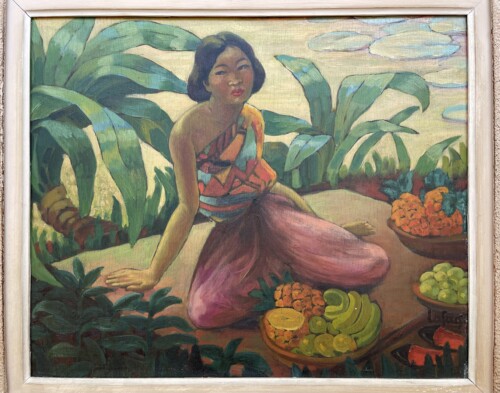
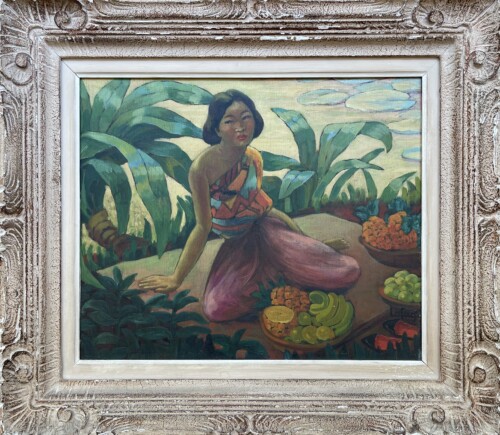 Léa Lafugie (1890-1972) est une peintre qui a voyagé à travers toute l’Asie. Elle est réputée pour ses portraits. Elle a étudié à l’École des Arts Décoratifs, puis à l’École des Beaux-Arts à Paris. Dotée d’un esprit aventurier et curieux, elle décide en 1925 de partir en voyage en Asie, notamment en Chine, en Inde, au Tibet, au Japon et sur la péninsule indochinoise. Elle a laissé de nombreux portraits féminins pris sur le vif lors de ses séjours. Pour référence, nous avons inclus une oeuvre similaire "Les Baigneuses Laotiennes" datant de 1949, ce qui nous permet de donner une date approximative à notre oeuvre. « La marchande de fruits laotienne.» Huile sur panneau. Signée en bas à droite. Encadrée. Circa années 40. Dimensions H : 46 cm ; L : 55,5 cm (sans cadre) H : 66 cm ; L : 75 cm (avec cadre) Léa Lafugie (1890–1972) was a painter who traveled extensively across Asia. She was renowned for her portraits. She studied at the School of Decorative Arts, followed by the École des Beaux-Arts in Paris. With an adventurous and curious spirit, she set off in 1925 on a journey through Asia, visiting countries such as China, India, Tibet, Japan, and the Indochinese Peninsula. During her travels, she created numerous spontaneous portraits of women, capturing them spontaneously. For reference we have included a similar painting "The Laotian Bathers" dating back to 1949, which allows us to pinpoint an approximate date for our painting. "The Laotian Fruit Seller" Oil on panel. Signed at the bottom right. Framed. Circa 1940s. Dimensions H : 46 cm ; W : 55.5 cm (without frame) H : 18 in ; W : 22 in (without frame) H : 66 cm ; W : 75 cm (with frame) H : 26 in ; W : 30 in (with frame)
Léa Lafugie (1890-1972) est une peintre qui a voyagé à travers toute l’Asie. Elle est réputée pour ses portraits. Elle a étudié à l’École des Arts Décoratifs, puis à l’École des Beaux-Arts à Paris. Dotée d’un esprit aventurier et curieux, elle décide en 1925 de partir en voyage en Asie, notamment en Chine, en Inde, au Tibet, au Japon et sur la péninsule indochinoise. Elle a laissé de nombreux portraits féminins pris sur le vif lors de ses séjours. Pour référence, nous avons inclus une oeuvre similaire "Les Baigneuses Laotiennes" datant de 1949, ce qui nous permet de donner une date approximative à notre oeuvre. « La marchande de fruits laotienne.» Huile sur panneau. Signée en bas à droite. Encadrée. Circa années 40. Dimensions H : 46 cm ; L : 55,5 cm (sans cadre) H : 66 cm ; L : 75 cm (avec cadre) Léa Lafugie (1890–1972) was a painter who traveled extensively across Asia. She was renowned for her portraits. She studied at the School of Decorative Arts, followed by the École des Beaux-Arts in Paris. With an adventurous and curious spirit, she set off in 1925 on a journey through Asia, visiting countries such as China, India, Tibet, Japan, and the Indochinese Peninsula. During her travels, she created numerous spontaneous portraits of women, capturing them spontaneously. For reference we have included a similar painting "The Laotian Bathers" dating back to 1949, which allows us to pinpoint an approximate date for our painting. "The Laotian Fruit Seller" Oil on panel. Signed at the bottom right. Framed. Circa 1940s. Dimensions H : 46 cm ; W : 55.5 cm (without frame) H : 18 in ; W : 22 in (without frame) H : 66 cm ; W : 75 cm (with frame) H : 26 in ; W : 30 in (with frame) -

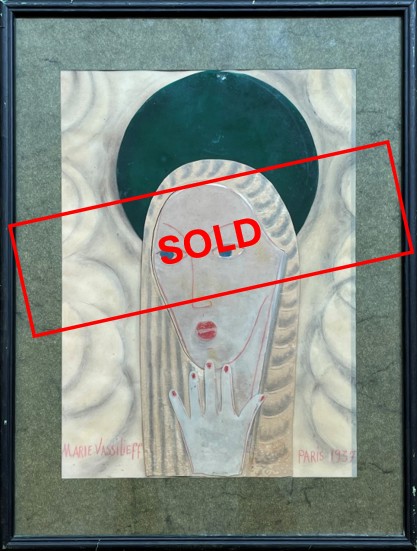 Marie Vassilieff (1884-1957) est une peintre et sculptrice d’origine russe, naturalisée française. Elle est connue pour son rôle central dans la vie artistique parisienne d'avant-garde, notamment à Montparnasse, où elle fonde sa propre école de peinture « l’Académie Vassilieff » transformée par la suite en cantine populaire pour artistes. Cette dernière est vite fréquentée par de nombreuses figures artistiques, dont Picasso, Modigliani et Fernand Léger. Influencée par le cubisme, elle réalise des portraits, ainsi que des poupées sculptées en tissu représentant ses amis artistes. Portrait de jeune femme Assemblage de papier et rhodoïd découpé, crayon gras et crayon noir. Signé en bas à gauche. Situé et daté « Paris 1937 » en bas à droite. Dimensions H : 30,5 cm ; L : 22 cm (sans cadre) H : 42 cm ; L : 32 cm (avec cadre)
Marie Vassilieff (1884-1957) est une peintre et sculptrice d’origine russe, naturalisée française. Elle est connue pour son rôle central dans la vie artistique parisienne d'avant-garde, notamment à Montparnasse, où elle fonde sa propre école de peinture « l’Académie Vassilieff » transformée par la suite en cantine populaire pour artistes. Cette dernière est vite fréquentée par de nombreuses figures artistiques, dont Picasso, Modigliani et Fernand Léger. Influencée par le cubisme, elle réalise des portraits, ainsi que des poupées sculptées en tissu représentant ses amis artistes. Portrait de jeune femme Assemblage de papier et rhodoïd découpé, crayon gras et crayon noir. Signé en bas à gauche. Situé et daté « Paris 1937 » en bas à droite. Dimensions H : 30,5 cm ; L : 22 cm (sans cadre) H : 42 cm ; L : 32 cm (avec cadre)
Marie Vassilieff (1884–1957) was a Russian-born painter and sculptor who later settled in France and became a key figure in the Parisian avant-garde. Closely associated with the Montparnasse art scene, she founded her own painting school : the “Académie Vassilieff”. It later became a popular canteen for struggling artists and a lively gathering place visited by major figures such as Picasso, Modigliani, and Fernand Léger. Strongly influenced by cubism, Vassilieff developed a distinctive style, creating expressive portraits as well as fabric dolls portraying her artist friends. Portrait of a Young Woman Collage of cut paper and acetate sheet (rhodoïd), grease pencil, and black pencil. Signed lower left. Located and dated "Paris 1937" lower right. Dimensions H : 30.5 cm ; W : 22 cm (unframed) H : 42 cm ; W : 32 cm (framed) -
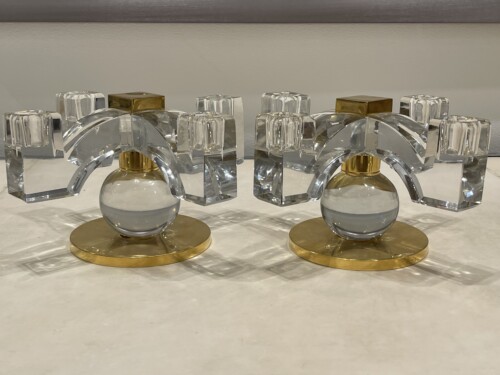
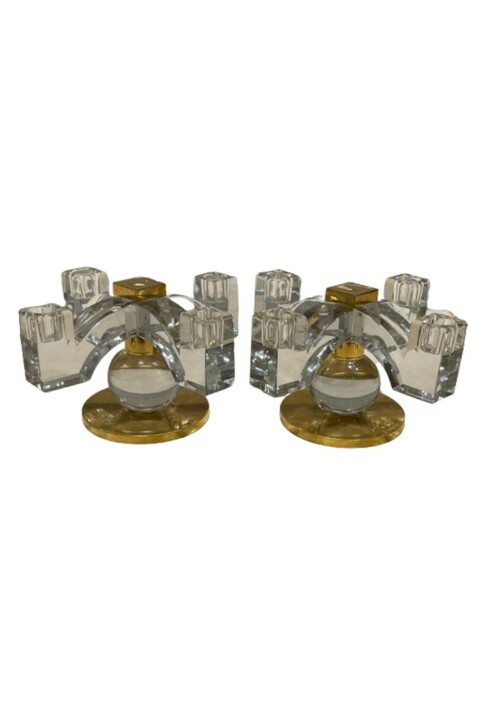 Fabuleuse paire de bougeoirs en cristal Baccarat à quatre bras de lumière, créée par Jacques Adnet. Jacques Adnet est un architecte et créateur français, qui a débuté sa carrière au sein d’un des premiers ateliers d’art moderne, La Maîtrise dirigé par Maurice Dufrêne. En 1928, Jacques Adnet se retrouve à la tête de la Compagnie des Arts Français et travaille avec de nombreux artistes comme Picasso, Dunand ou encore Perriand. Grâce à ses œuvres aux motifs épurés, simples, aux matériaux nouveaux comme le verre et le métal, il est considéré comme un des principaux représentants du modernisme et de l’Art Déco français. Baccarat est née d'une association d’artisans de l’Est de la France, qui parvient en 1764 à créer un verre d’une grande qualité, puis en 1816, à développer un cristal d’une pureté inégalée. Baccarat a dès lors acquis sa réputation de créateur de luxe, l’entreprise a notamment fourni du mobilier aux Maharaja des Indes, a créé des candélabres pour Nicolas II de Russie, ou encore de nombreuses pièces pour les appartements de Napoléon III au Louvre. Les plus grands artistes ont travaillé avec Baccarat, comme Salvador Dali, Philippe Starck ou encore Jacques Adnet. Cette paire de bougeoirs est le fruit d'une collaboration entre Adnet et Baccarat, modèle créé en 1935. Il présente une base cylindrique, un fut ornementé d’une boule de cristal et quatre bras de lumière. Les lignes sont épurées, simplifiées témoignant d’une grande modernité. Les créations de Jacques Adnet sont reconnaissables grâce à l’alliage du bronze doré et de la boule de cristal Baccarat que l’on connaît également dans ses lampes de table. Cette paire est signée sous chacune des bases du cachet “Baccarat” et numérotée 7957. Dimensions : H. 13cm D. 22cm Pour découvrir Jacques Adnet, cliquez ici
Fabuleuse paire de bougeoirs en cristal Baccarat à quatre bras de lumière, créée par Jacques Adnet. Jacques Adnet est un architecte et créateur français, qui a débuté sa carrière au sein d’un des premiers ateliers d’art moderne, La Maîtrise dirigé par Maurice Dufrêne. En 1928, Jacques Adnet se retrouve à la tête de la Compagnie des Arts Français et travaille avec de nombreux artistes comme Picasso, Dunand ou encore Perriand. Grâce à ses œuvres aux motifs épurés, simples, aux matériaux nouveaux comme le verre et le métal, il est considéré comme un des principaux représentants du modernisme et de l’Art Déco français. Baccarat est née d'une association d’artisans de l’Est de la France, qui parvient en 1764 à créer un verre d’une grande qualité, puis en 1816, à développer un cristal d’une pureté inégalée. Baccarat a dès lors acquis sa réputation de créateur de luxe, l’entreprise a notamment fourni du mobilier aux Maharaja des Indes, a créé des candélabres pour Nicolas II de Russie, ou encore de nombreuses pièces pour les appartements de Napoléon III au Louvre. Les plus grands artistes ont travaillé avec Baccarat, comme Salvador Dali, Philippe Starck ou encore Jacques Adnet. Cette paire de bougeoirs est le fruit d'une collaboration entre Adnet et Baccarat, modèle créé en 1935. Il présente une base cylindrique, un fut ornementé d’une boule de cristal et quatre bras de lumière. Les lignes sont épurées, simplifiées témoignant d’une grande modernité. Les créations de Jacques Adnet sont reconnaissables grâce à l’alliage du bronze doré et de la boule de cristal Baccarat que l’on connaît également dans ses lampes de table. Cette paire est signée sous chacune des bases du cachet “Baccarat” et numérotée 7957. Dimensions : H. 13cm D. 22cm Pour découvrir Jacques Adnet, cliquez ici
Fabulous pair of Baccarat crystal candelabras with four light arms, created by Jacques Adnet. Jacques Adnet, a French architect and designer, began his career at one of the first modern art workshops, La Maîtrise, directed by Maurice Dufrêne. In 1928, Jacques Adnet found himself at the helm of the Compagnie des Arts Français, collaborating with numerous artists such as Picasso, Dunand, and Perriand. Thanks to his works featuring clean, simple patterns and the use of new materials like glass and metal, he is considered one of the main representatives of French modernism and Art Deco. Baccarat originated from an association of artisans in Eastern France, achieving the creation of high-quality glass in 1764 and developing unparalleled crystal purity in 1816. Baccarat gained a reputation for luxury creations, supplying furniture to the Maharajas of India, crafting candelabras for Nicholas II of Russia, and creating numerous pieces for Napoleon III's apartments at the Louvre. Prominent artists such as Salvador Dali, Philippe Starck, and Jacques Adnet have collaborated with Baccarat. This pair of candlesticks is the result of collaboration between Adnet and Baccarat, with the model created in 1935. It features a cylindrical base, a stem ornamented with a Baccarat crystal ball, and four light arms. The lines are clean and simplified, showcasing a great sense of modernity. Jacques Adnet's creations are recognizable through the combination of gilded bronze and Baccarat crystal balls, as seen in his table lamps. This pair is signed under each base with the "Baccarat" stamp and numbered 7957. Dimensions : H. 13cm D. 22cm For more informations about Jacques Adnet, please click here -
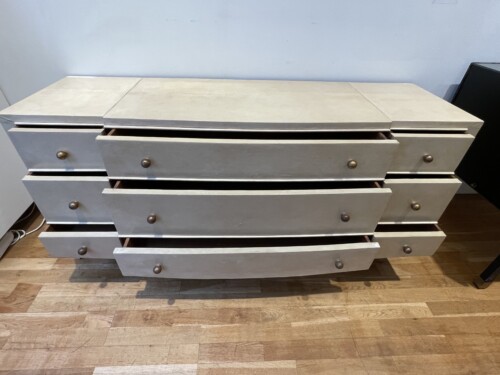
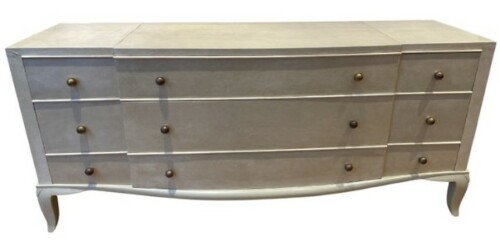 André Arbus (1903-1969), ébéniste et décorateur français, est reconnu pour son style néo-classique raffiné qui marie élégance et tradition. Formé aux Beaux-Arts et enraciné dans l'artisanat familial, il se distingue dès l’Exposition Internationale des Arts Décoratifs de 1925. Fidèle à l'héritage français, il travaille des matériaux nobles comme le sycomore et la laque, et orne ses pièces de détails sculptés inspirés de l'époque classique. Arbus conçoit des meubles à la fois somptueux et fonctionnels, portant l’empreinte d'une tradition revisitée avec modernité et finesse.
André Arbus (1903-1969), ébéniste et décorateur français, est reconnu pour son style néo-classique raffiné qui marie élégance et tradition. Formé aux Beaux-Arts et enraciné dans l'artisanat familial, il se distingue dès l’Exposition Internationale des Arts Décoratifs de 1925. Fidèle à l'héritage français, il travaille des matériaux nobles comme le sycomore et la laque, et orne ses pièces de détails sculptés inspirés de l'époque classique. Arbus conçoit des meubles à la fois somptueux et fonctionnels, portant l’empreinte d'une tradition revisitée avec modernité et finesse.- Entièrement recouverte de parchemin.
- Circa 1935.
- Une variante au modèle a été acquise par le Mobilier National et présentée lors de l'exposition “Le Chic ! Arts décoratifs et mobilier de 1930 à 1960” à la Galerie des Gobelins en 2023
- Neuf tiroirs.
André Arbus (1903-1969), a French cabinetmaker and decorator, is recognized for his refined neoclassical style that blends elegance and tradition. Trained at the Beaux-Arts and rooted in his family's craftsmanship, he distinguished himself at the International Exhibition of Decorative Arts in 1925. Faithful to French heritage, he works with noble materials such as sycamore and lacquer, adorning his pieces with sculpted details inspired by classical times. Arbus designs furniture that is both sumptuous and functional, bearing the mark of a tradition reinterpreted with modernity and finesse.- Completely covered in parchment.
- Circa 1935.
- One model was acquired by the Mobilier National and presented in the exhibition “Le Chic! Decorative Arts and Furniture from 1930 to 1960” at the Galerie des Gobelins, 2023.
- Nine drawers.
-

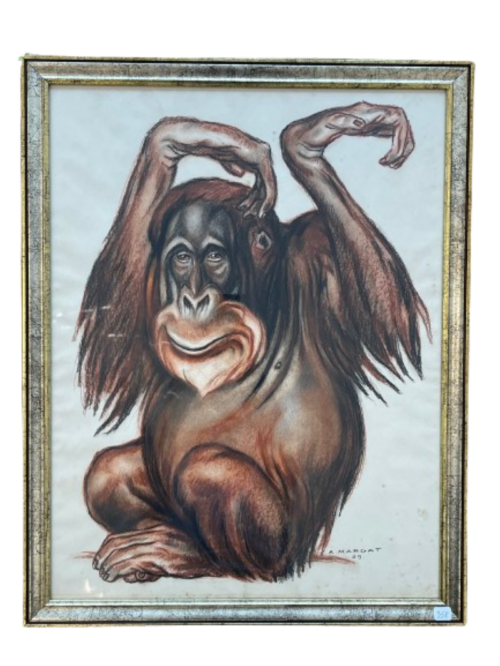 André Margat est un artiste français largement connu pour ses représentations d'animaux. Il est membre du « Groupe des Douze », une association d'artistes créée en 1932 dans le but de présenter l'art animalier français lors d'expositions et d'honorer un artiste chaque année.
André Margat est un artiste français largement connu pour ses représentations d'animaux. Il est membre du « Groupe des Douze », une association d'artistes créée en 1932 dans le but de présenter l'art animalier français lors d'expositions et d'honorer un artiste chaque année.- Dessin au pastel.
- Signé en bas à droite et daté (19)29.
- Drawing in pastel.
- Signed at lower right and dated (19)29.
-
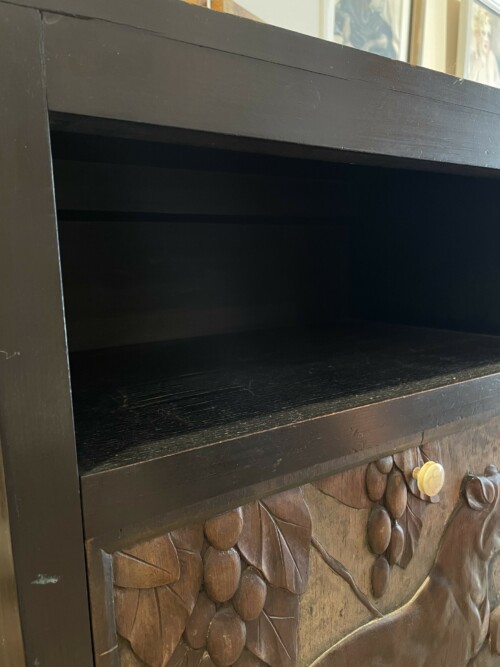
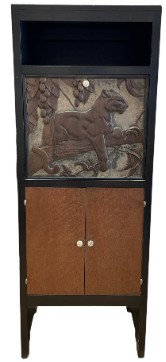 Georges Henri Laurent (1880-1940) est un artiste décorateur et peintre français, actif durant la première moitié du XXe siècle. Membre de l’Union des Artistes Modernes (UAM) avec notamment Robert Mallet-Stevens et Le Corbusier, il participe au renouveau des arts décoratifs en France dans un esprit moderniste. Il se distingue par son travail dans les domaines du mobilier, de la décoration intérieure et de la sculpture, adoptant des formes sobres et fonctionnelles, en accord avec les principes de l’UAM. Son œuvre reflète une recherche d’harmonie entre utilité et esthétique. Cabinet en bois noirci Corps quadrangulaire ouvrant par un casier en partie haute, un abattant en partie centrale entièrement sculpté recto verso d’un félin branché et d’un temple khmer, et en partie basse par deux portes pleines en placage de loupe. Piètement latéral plein à décroché en partie basse. Sauts de placage, éraflures, taches, petit jour entre l’abattant et les portes en partie basse. Prises de tirage conique à décor peint d’une fleur stylisée. Signé. Dimensions H : 150 cm ; L 55 ,5 cm ; P : 34 cm
Georges Henri Laurent (1880-1940) est un artiste décorateur et peintre français, actif durant la première moitié du XXe siècle. Membre de l’Union des Artistes Modernes (UAM) avec notamment Robert Mallet-Stevens et Le Corbusier, il participe au renouveau des arts décoratifs en France dans un esprit moderniste. Il se distingue par son travail dans les domaines du mobilier, de la décoration intérieure et de la sculpture, adoptant des formes sobres et fonctionnelles, en accord avec les principes de l’UAM. Son œuvre reflète une recherche d’harmonie entre utilité et esthétique. Cabinet en bois noirci Corps quadrangulaire ouvrant par un casier en partie haute, un abattant en partie centrale entièrement sculpté recto verso d’un félin branché et d’un temple khmer, et en partie basse par deux portes pleines en placage de loupe. Piètement latéral plein à décroché en partie basse. Sauts de placage, éraflures, taches, petit jour entre l’abattant et les portes en partie basse. Prises de tirage conique à décor peint d’une fleur stylisée. Signé. Dimensions H : 150 cm ; L 55 ,5 cm ; P : 34 cm
Georges Henri Laurent (1880–1940) was a French decorative artist and painter, active during the first half of the 20th century. A member of the Union des Artistes Modernes (UAM) alongside figures such as Robert Mallet-Stevens and Le Corbusier, he contributed to the revival of decorative arts in France with a modernist spirit. He stood out for his work in furniture, interior decoration, and textile design, embracing clean and functional forms in line with the UAM's principles. His work reflects a pursuit of harmony between utility and aesthetics. Blackened wood cabinet Quadrangular body opening with an upper compartment, a central drop-down panel entirely carved on both sides with a perched feline and a Khmer temple, and a lower section with two solid doors in burled wood veneer. Solid side base with a recessed lower section. With veneer losses, scratches, stains, and a slight gap between the drop-front and the lower doors. Conical drawer pulls painted with a stylized flower motif. Signed. Dimensions H : 150 cm; W : 55.5 cm; D : 34 cm H : 59 in ; W : 21.9 in ; D : 13.4 in -
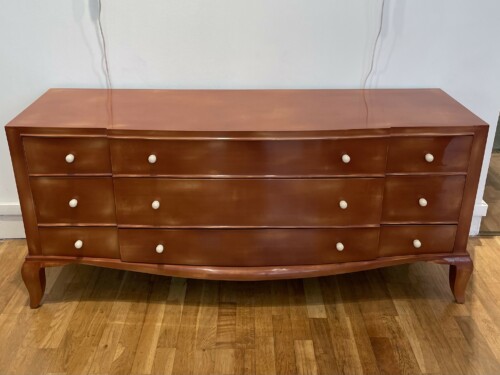
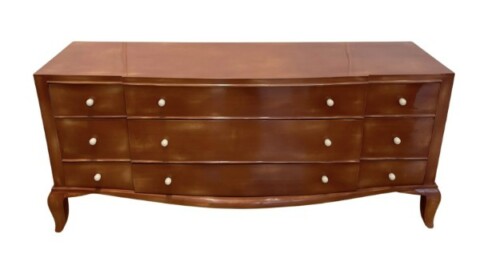 André Arbus (1903-1969) ébéniste et décorateur français, est reconnu pour son style néo-classique raffiné qui marie élégance et tradition. Formé aux Beaux-Arts et enraciné dans l’artisanat familial, il se distingue dès l’Exposition Internationale des Arts Décoratifs de 1925. Fidèle à l’héritage français, il travaille des matériaux nobles comme le sycomore et la laque, et orne ses pièces de détails sculptés inspirés de l’époque classique. Arbus conçoit des meubles à la fois somptueux et fonctionnels, portant l’empreinte d’une tradition revisitée avec modernité et finesse. Commode dite « Pantalonnière » Chêne laqué, laque de Chine brune. Circa 1935. Une variante au modèle a été acquise par le Mobilier National et présentée lors de l’exposition “Le Chic ! Arts décoratifs et mobilier de 1930 à 1960” à la Galerie des Gobelins en 2023. Neuf tiroirs. Dimensions H : 66,5 cm ; L : 155,5 cm ; P : 47,5 cm
André Arbus (1903-1969) ébéniste et décorateur français, est reconnu pour son style néo-classique raffiné qui marie élégance et tradition. Formé aux Beaux-Arts et enraciné dans l’artisanat familial, il se distingue dès l’Exposition Internationale des Arts Décoratifs de 1925. Fidèle à l’héritage français, il travaille des matériaux nobles comme le sycomore et la laque, et orne ses pièces de détails sculptés inspirés de l’époque classique. Arbus conçoit des meubles à la fois somptueux et fonctionnels, portant l’empreinte d’une tradition revisitée avec modernité et finesse. Commode dite « Pantalonnière » Chêne laqué, laque de Chine brune. Circa 1935. Une variante au modèle a été acquise par le Mobilier National et présentée lors de l’exposition “Le Chic ! Arts décoratifs et mobilier de 1930 à 1960” à la Galerie des Gobelins en 2023. Neuf tiroirs. Dimensions H : 66,5 cm ; L : 155,5 cm ; P : 47,5 cm
André Arbus (1903–1969), a French cabinetmaker and decorator, is renowned for his refined neoclassical style that blends elegance and tradition. Trained at the École des Beaux-Arts and rooted in his family's craft heritage, he gained recognition at the 1925 International Exhibition of Decorative Arts. Faithful to French heritage, he worked with fine materials such as sycamore and lacquer, embellishing his creations with sculpted details inspired by the classical era. Arbus designed furniture that was both luxurious and functional, reflecting a tradition reinterpreted with modernity and finesse. "Pantalonnière" Chest of Drawers Lacquered oak, brown Chinese lacquer. Circa 1935. A variant of this model was acquired by the Mobilier National and featured in the exhibition “Le Chic! Decorative Arts and Furniture from 1930 to 1960” at the Galerie des Gobelins in 2023. Nine drawers. Dimensions H : 66.5 cm; W : 155.5 cm; D : 47.5 cm H : 26.2 in ; W : 61.2 in ; D : 18.7 in -

 GIO PONTI, Etagère en laiton et verre, Circa 1939 Elégante étagère de laiton et de verre, comportant cinq étagères soutenues de bois maintenues par deux lames de verres aux extrémités, le tout solidement relié et fixé par des vis en laiton. Le verre est engravé « Vitrex » Réalisé à l’origine pour les bureaux de la société Ventrocoke à Milan Gio Ponti est diplômé de l’Ecole Polytechnique de Milan, et ouvre en 1921 son cabinet d’architecture. Il est nommé directeur artistique de la manufacture de porcelaine Richard-Ginori en 1923. En 1925,il remporte un grand prix à l’Exposition internationale des Arts Décoratifs de Paris. Il collabore également avec les marques Christofle à Paris et Venini à Murano. En parallèle, il crééé galement des séries de meubles Art Deco à des prix accessibles , La Rinascente, pour les grands magasins italiens un choix. S’ajoute à cela sa revue Domus fondée en 1928 dans laquelle il mettra en avant le « made in italy ». Dans les années 1930, il entame la construction des Case Tipiche, à Milan, et des bureaux pour la société Montecatini. En 1940, il se consacre au Palazzo del Bo de l’université de Padoue. Pour finir de 1950 à 1960, Gio Ponti sera surtout connu pour son architecture qu’il déployera à travers le monde Dimensions : H : 84 cm L : 88 cm P : 37 cm
GIO PONTI, Etagère en laiton et verre, Circa 1939 Elégante étagère de laiton et de verre, comportant cinq étagères soutenues de bois maintenues par deux lames de verres aux extrémités, le tout solidement relié et fixé par des vis en laiton. Le verre est engravé « Vitrex » Réalisé à l’origine pour les bureaux de la société Ventrocoke à Milan Gio Ponti est diplômé de l’Ecole Polytechnique de Milan, et ouvre en 1921 son cabinet d’architecture. Il est nommé directeur artistique de la manufacture de porcelaine Richard-Ginori en 1923. En 1925,il remporte un grand prix à l’Exposition internationale des Arts Décoratifs de Paris. Il collabore également avec les marques Christofle à Paris et Venini à Murano. En parallèle, il crééé galement des séries de meubles Art Deco à des prix accessibles , La Rinascente, pour les grands magasins italiens un choix. S’ajoute à cela sa revue Domus fondée en 1928 dans laquelle il mettra en avant le « made in italy ». Dans les années 1930, il entame la construction des Case Tipiche, à Milan, et des bureaux pour la société Montecatini. En 1940, il se consacre au Palazzo del Bo de l’université de Padoue. Pour finir de 1950 à 1960, Gio Ponti sera surtout connu pour son architecture qu’il déployera à travers le monde Dimensions : H : 84 cm L : 88 cm P : 37 cm
GIO PONTI, Brass and glass shelf, Circa 1939 Elegant brass and glass shelf, featuring five supported wooden shelves held by two glass blades at the ends, all securely connected and fixed by brass screws. The glass is engraved «Vitrex» Originally designed for the Ventrocoke offices in Milan Gio Ponti graduated from the Polytechnic of Milan, and opened his architectural practice in 1921. He was appointed artistic director of the Richard-Ginori porcelain factory in 1923. In 1925, he won a grand prize at the International Exhibition of Decorative Arts in Paris. He also collaborates with the brands Christofle in Paris and Venini in Murano. In parallel, he also created series of Art Deco furniture at affordable prices , La Rinascente, for Italian department stores a choice. In addition to this, his magazine Domus, founded in 1928, will highlight the «made in italy». In the 1930s, he began the construction of the Case Tipiche in Milan and offices for the company Montecatini. In 1940 he dedicated himself to the Palazzo del Bo of the University of Padua. To finish from 1950 to 1960, Gio Ponti will be best known for his architecture that he will deploy around the world Dimensions: H: 33.1 in W: 34.5 in D: 14.5 in -
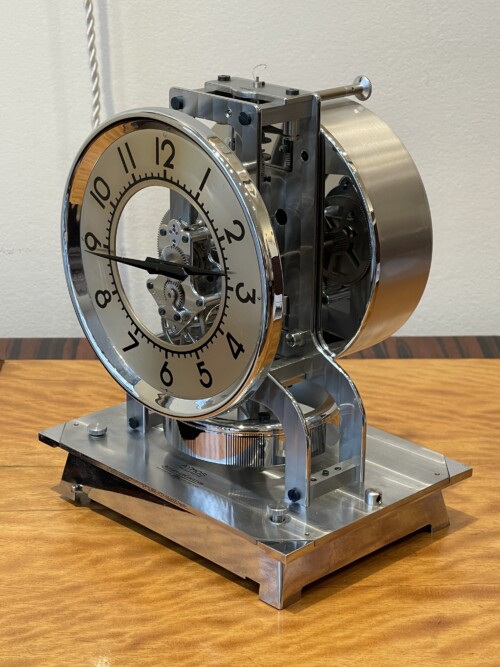
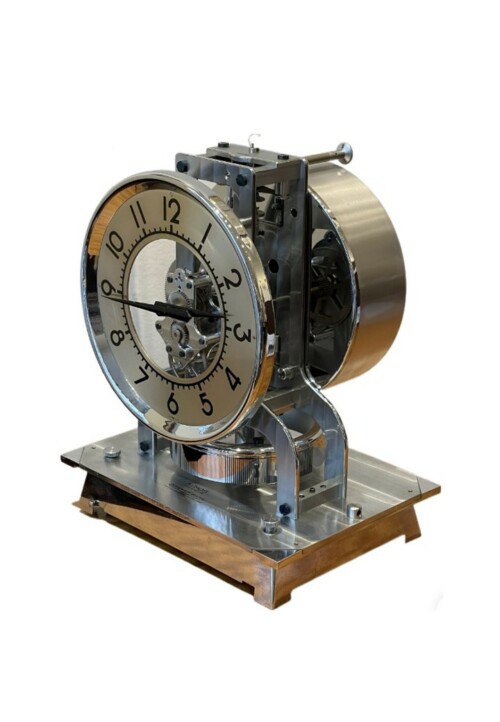
- Vers 1940.
- Faite en métal chromé. La pendule repose sur un socle en métal chromé, et dispose également d’un boîtier vitré en bois. Le cadran est évidé au centre avec un mécanisme apparent, le cercle est argenté avec des chiffres arabes dits “Art Déco”.
- A été révisée par un horloger professionnel et elle est dans un bon état.
- Porte la mention “Fabriqué en Suisse”.
- Signé sur la base “Jaeger-Le Coultre” et “Atmos Brevets Reutter”.
- Circa 1940.
- Made of chromed metal, the clock rests on a chromed metal base and features a glazed wooden case. The dial is open in the center, revealing the mechanism, with a silvered ring and Art Deco-style Arabic numerals.
- It has been serviced by a professional watchmaker and is in good condition.
- It bears the label “Made in Switzerland” and is signed on the base “Jaeger-LeCoultre” and “Atmos Brevets Reutter.”
-
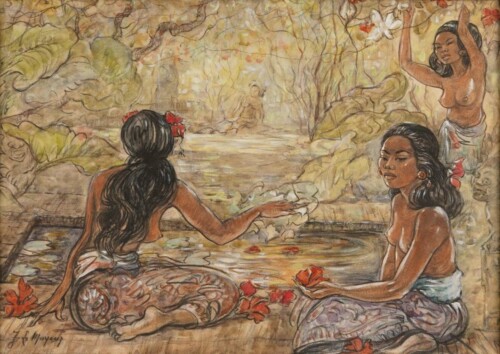
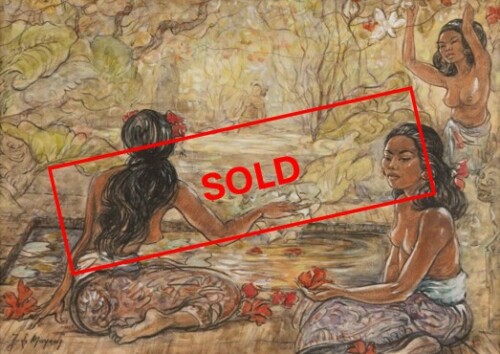
The work is typical of Le Mayeur de Merpres, a Belgian painter, who represented many scenes of everyday life in Bali in the 30s-40s, married to an Indonesian woman Ni Pollok. Le Mayeur came to Bali at Singaraja in 1932. He then stayed in Denpasar and was fascinated by what remained then of Balinese culture, including the people's traditional way of life, the temple rituals and local dances. He was also impressed by the light, color and beauty of the surroundings in the then still quite unspoilt island.- Mixed technique on paper.
- Circa 1940s.
- Signed at lower left.
